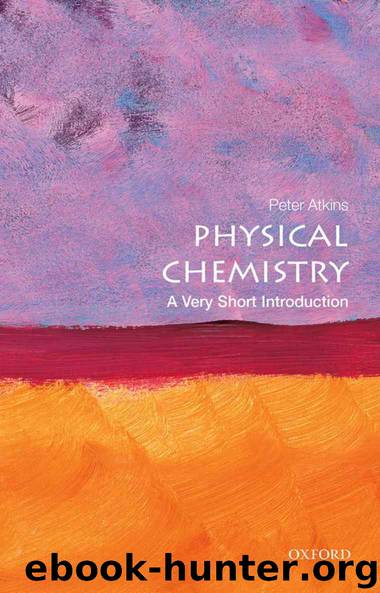Physical Chemistry: A Very Short Introduction (Very Short Introductions) by Peter Atkins

Author:Peter Atkins [Atkins, Peter]
Language: eng
Format: epub, mobi
Publisher: Oxford University Press
Published: 2014-04-06T00:00:00+00:00
Solid
Physical chemistry is on much firmer ground with solids. Here, instead of motion being paramount (as in gases), motion constrained but important (as in liquids), to a first approximation there is no motion at all for all the atoms of a solid can be regarded as in fixed positions. Motion does survive in solids, but it is largely just the quivering of molecules in place as they vibrate, and initially can be ignored.
The principal experimental technique for the determination of the structures of solids is X-ray diffraction (or ‘X-ray crystallography’). However, I have to admit that so central is an understanding of the arrangement of atoms in molecules to molecular biology and inorganic chemistry, that molecular biologists and inorganic chemists probably regard X-ray diffraction as their own; indeed, I think it true to say that physical chemists on the whole are happy to let slip the technique from their intellectual grasp but keep a tight grip on its conclusions. Their conclusions overlap with the interests of materials scientists, for here, as in biology, structure is allied closely with function.
That—the distance that physical chemists largely keep from the technique itself—being so, I will not dwell on it for more than a sentence or so, and focus instead on what it reveals. In short, X-ray diffraction makes use of the fact that electromagnetic radiation (which includes X-rays) consists of waves that can interfere with one another and give rise to regions of enhanced and diminished intensity. This so-called ‘diffraction pattern’ is characteristic of the object in the path of the rays, and mathematical procedures can be used to interpret the pattern in terms of the object’s structure. Diffraction occurs when the wavelength of the radiation is comparable to the dimensions of the object. X-rays have wavelengths comparable to the separation of atoms in solids, so are ideal for investigating their arrangement.
Crystals, as was speculated long ago by René Haüy (1743–1822) in about 1784, following similar speculations by Johannes Kepler in 1611 and Robert Hooke in 1665, and confirmed by X-ray diffraction in the 20th century, consist of serried ranks of atoms in uniform arrays. The most primitive model for accounting for the structures of crystals of elemental metals (silver, copper, iron, etc.) is to regard each atom as a hard sphere and to consider how these spheres may be stacked together in layers to reproduce the entire crystal. Many metals have ‘close-packed’ structures in which the spheres pack together in the most efficient way possible (Figure 15). One consequence is that metals are dense materials as so much space is occupied by their closely packed atoms.
Ionic solids present a double problem: cations and anions have different radii and opposite charges. The lowest energy arrangement is obtained only if cations are surrounded by anions, and vice versa (the sodium chloride structure shown in Figure 3 (Chapter 1) is an example). This requirement puts a severe restraint on the possible arrangements of the ions and the dense close packing characteristic of metals is never achieved.
Download
Physical Chemistry: A Very Short Introduction (Very Short Introductions) by Peter Atkins.mobi
This site does not store any files on its server. We only index and link to content provided by other sites. Please contact the content providers to delete copyright contents if any and email us, we'll remove relevant links or contents immediately.
| Electrochemistry | Physical Chemistry |
| Quantum Chemistry |
Alchemy and Alchemists by C. J. S. Thompson(3448)
The Elements by Theodore Gray(2996)
The Club by A.L. Brooks(2862)
How to Make Your Own Soap by Sally Hornsey(2826)
Drugs Unlimited by Mike Power(2544)
Wheels of Life by Anodea Judith(2095)
Cracking the LSAT, 2012 Edition by Princeton Review(1872)
Cracking the Sat French Subject Test, 2013-2014 Edition by The Princeton Review(1827)
Perfume by Jean-Claude Ellena(1781)
The Flavor Matrix by James Briscione(1774)
The Cosmic Machine: The Science That Runs Our Universe and the Story Behind It by Scott Bembenek(1725)
MCAT Physics and Math Review by Princeton Review(1634)
1000 Multiple-Choice Questions in Organic Chemistry by Organic Chemistry Academy(1621)
The Thing Around Your Neck by Chimamanda Ngozi Adichie(1599)
Handbook of Modern Sensors by Jacob Fraden(1543)
Cracking the SAT Premium Edition with 6 Practice Tests, 2017 by Princeton Review(1535)
Synchrotron Light Sources and Free-Electron Lasers by Eberhard J. Jaeschke Shaukat Khan Jochen R. Schneider & Jerome B. Hastings(1524)
A is for Arsenic: The Poisons of Agatha Christie (Bloomsbury Sigma) by Kathryn Harkup(1506)
Harry Potter All Books: 8 Books by J.k.rowling(1491)
